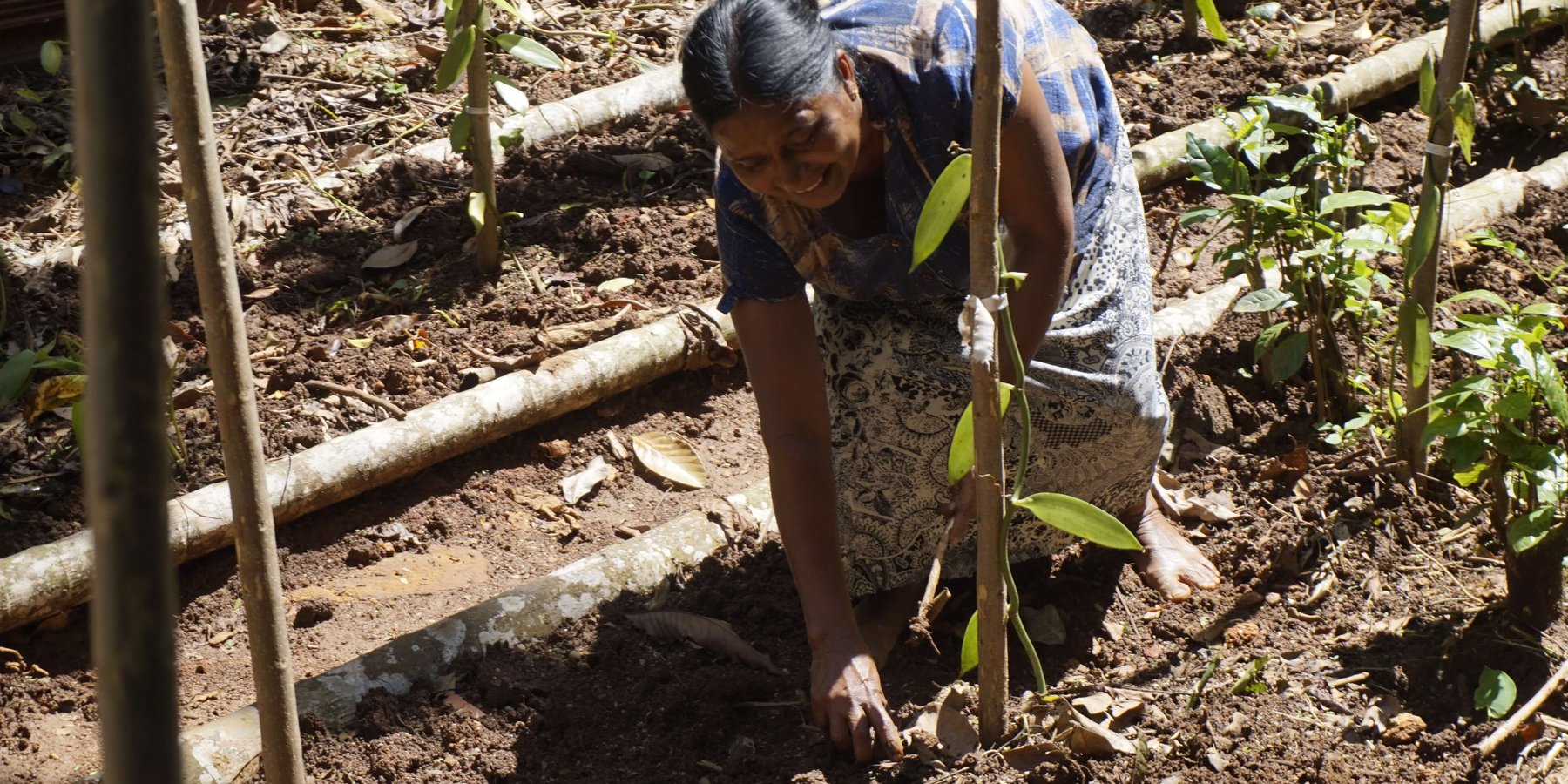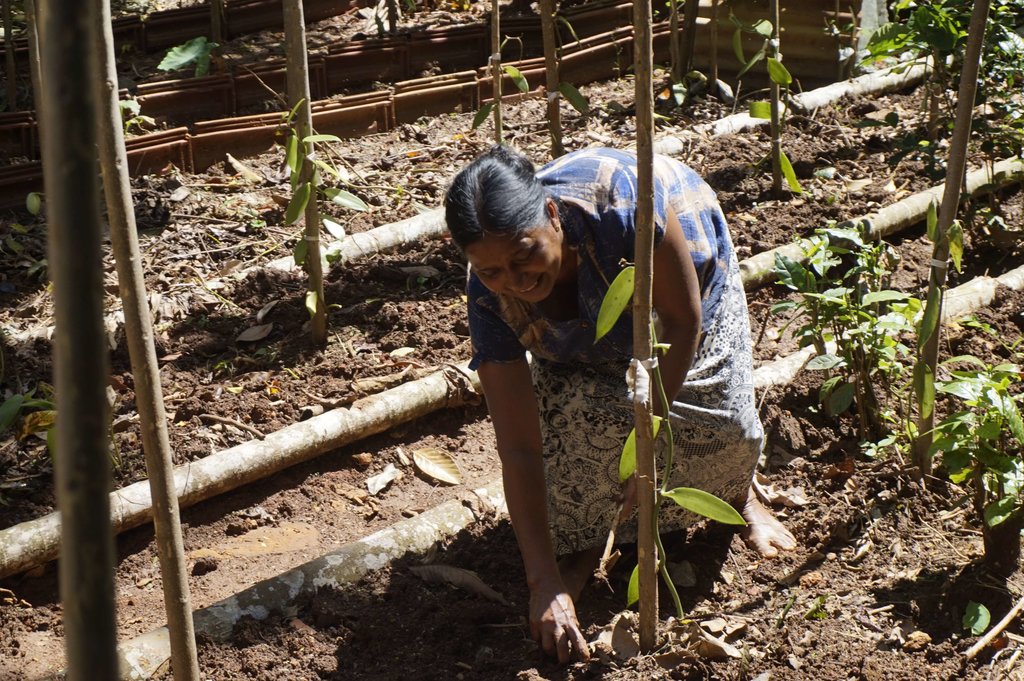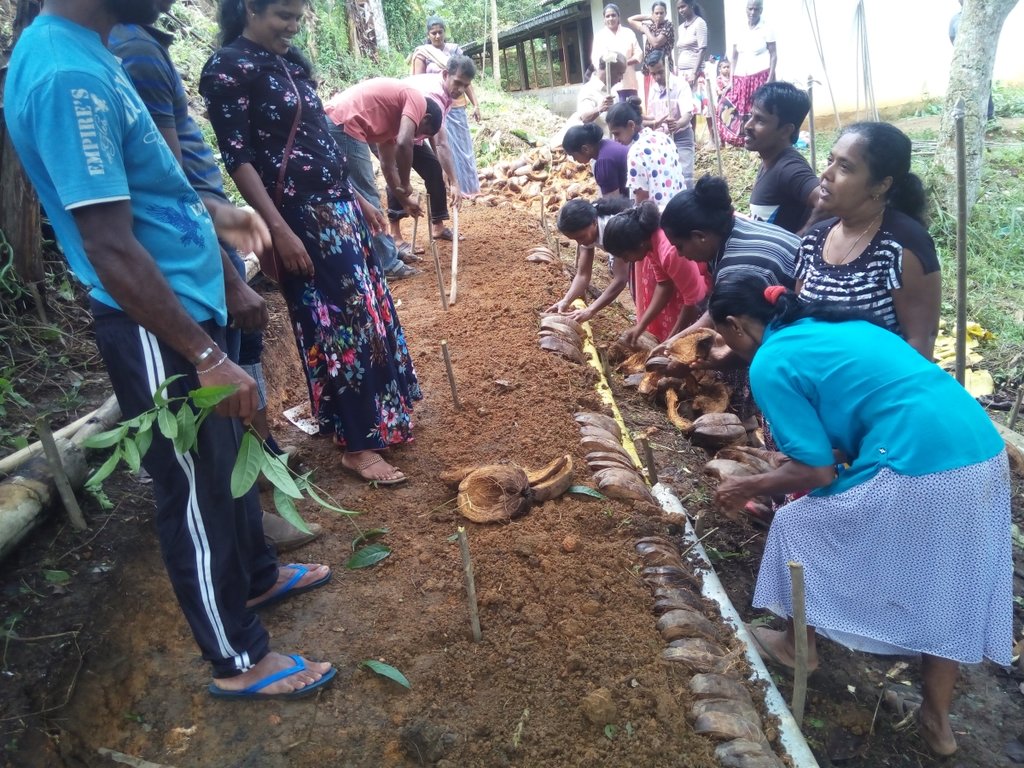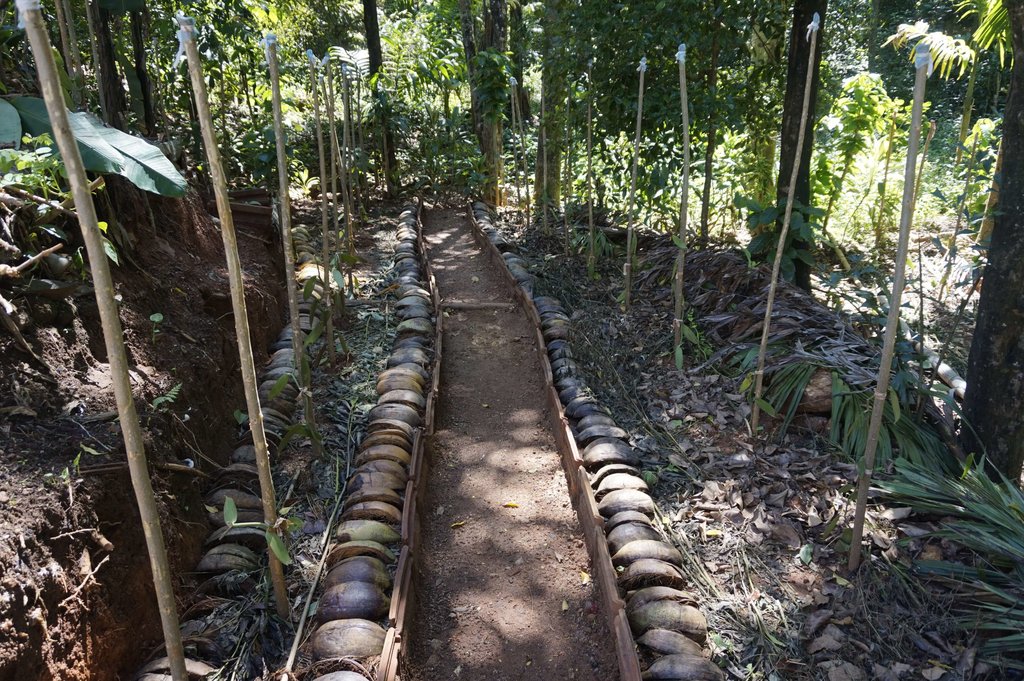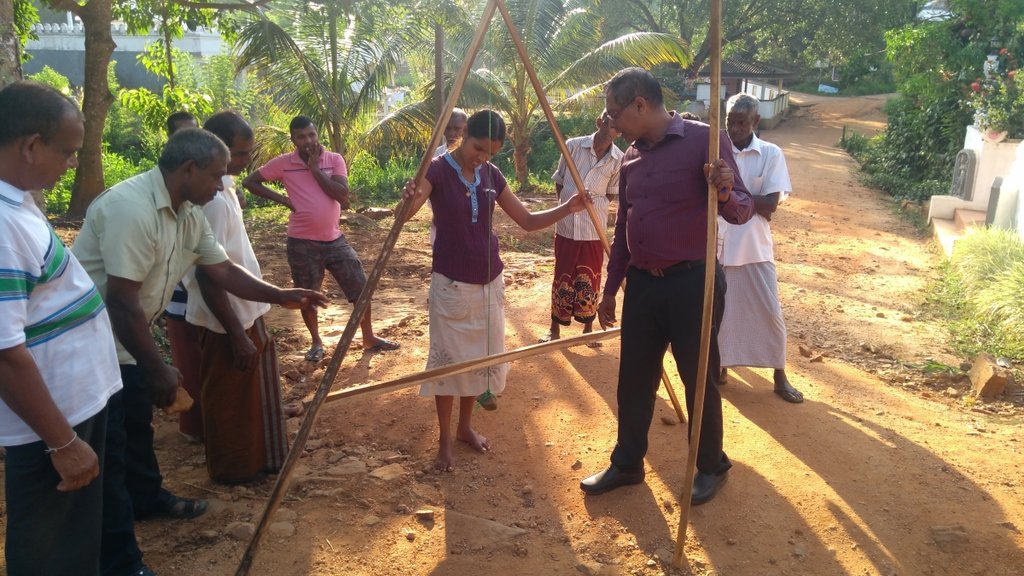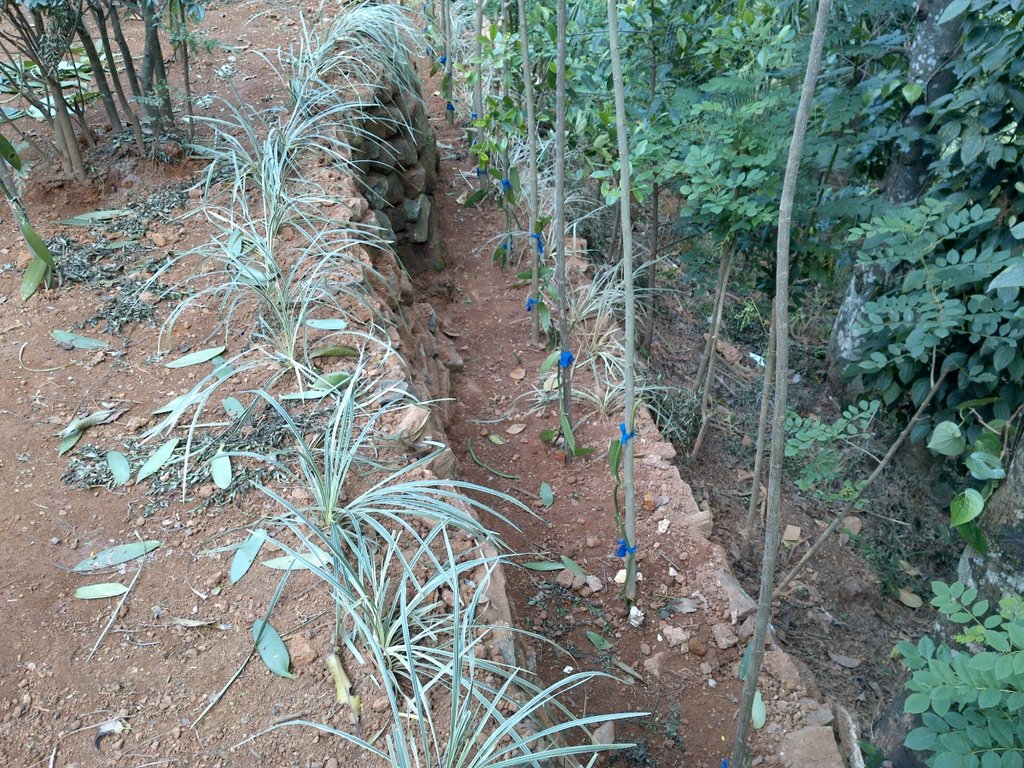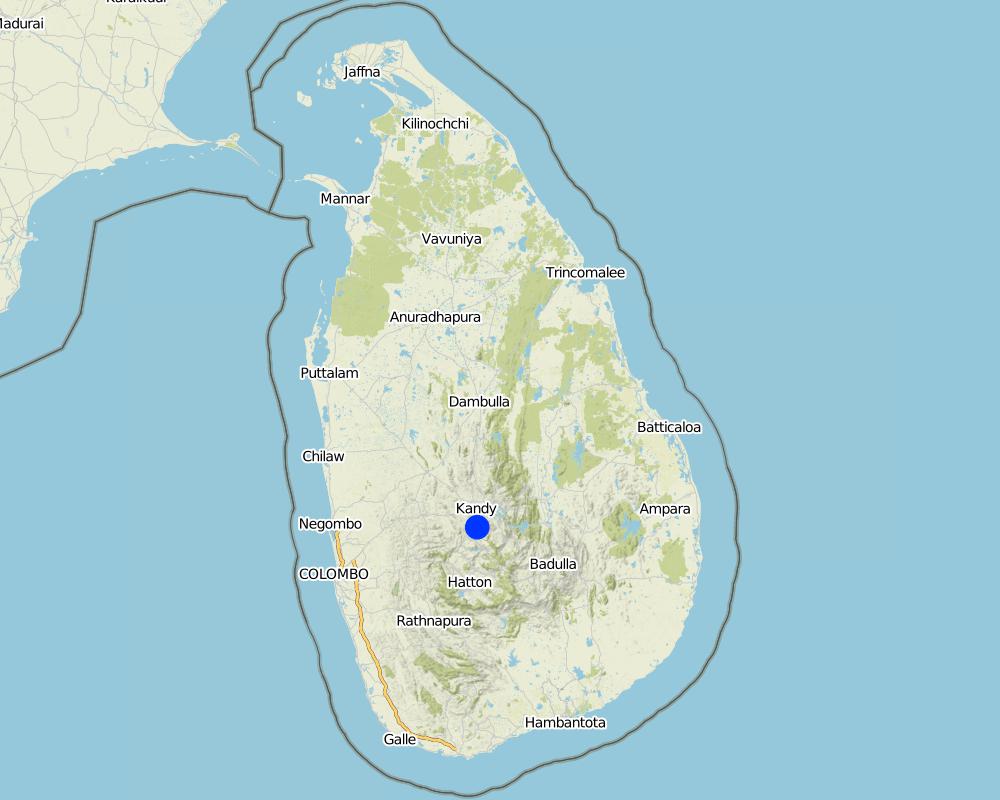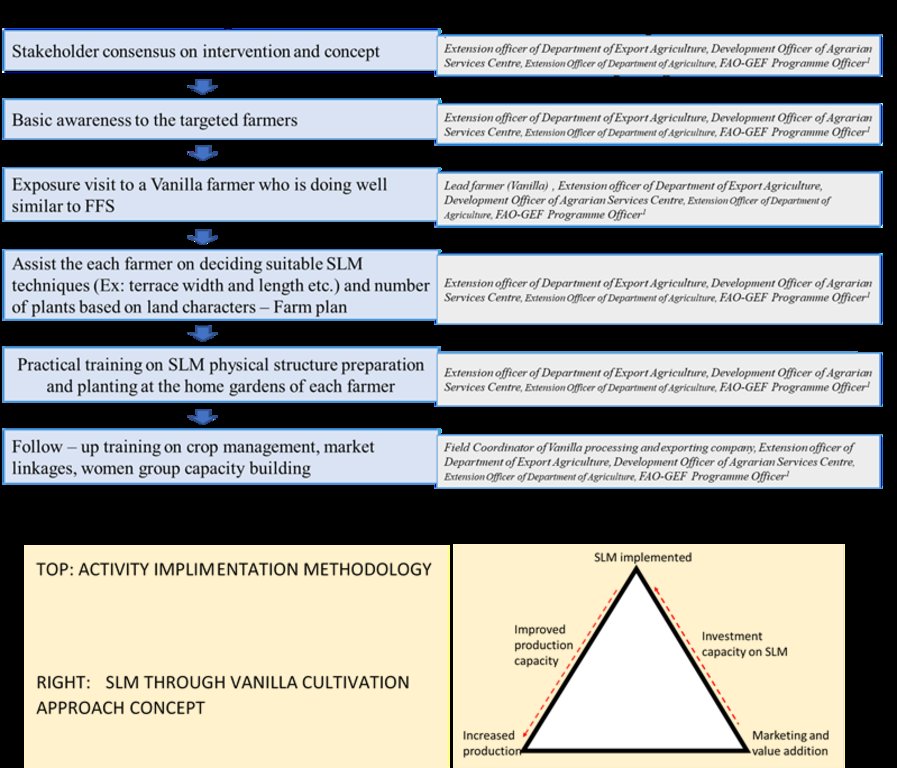Women practices SLM through Vanilla cultivation [Sri Lanka]
- Creation:
- Update:
- Compiler: Bandara Rotawewa
- Editor: –
- Reviewer: Ursula Gaemperli
Women practices SLM through Vanilla cultivation
approaches_5177 - Sri Lanka
View sections
Expand all Collapse all1. General information
1.2 Contact details of resource persons and institutions involved in the assessment and documentation of the Approach
Nimal Gunasena
Upul Jayaweera
Tissa Wathukarage
Name of project which facilitated the documentation/ evaluation of the Approach (if relevant)
Rehabilitation of Degraded Agricultural Lands in Kandy, Badulla and Nuwara Eliya Districts in the Central Highlands of Sri Lanka1.3 Conditions regarding the use of data documented through WOCAT
When were the data compiled (in the field)?
03/01/2019
The compiler and key resource person(s) accept the conditions regarding the use of data documented through WOCAT:
Yes
1.4 Reference(s) to Questionnaire(s) on SLM Technologies

Crop-livestock integration to enhance soil productivity [Sri Lanka]
Crop-livestock integration improves nutrient circularity and soil productivity: solid and liquid organic fertilizers prepared from cow manure are incorporated to soil or sprayed on leaves of vegetables and tea.
- Compiler: Head Soil Science
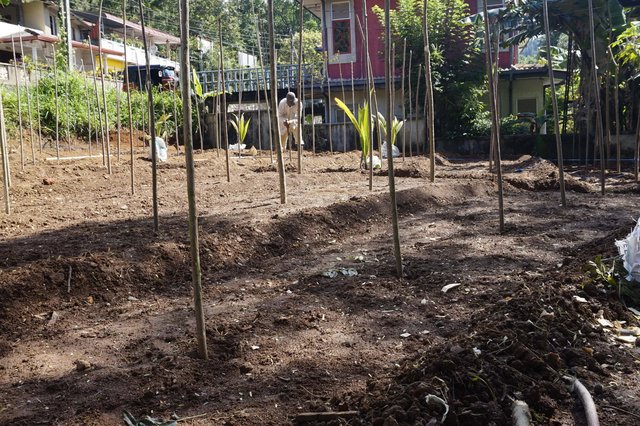
Individual platforms and contour platforms [Sri Lanka]
Construction of individual platforms or contour platforms to control soil erosion in the home gardens (HG) to cultivate vanilla as a cash crop
- Compiler: Bandara Rotawewa
2. Description of the SLM Approach
2.1 Short description of the Approach
Women in Central Highlands of Sri Lanka practice sustainable land management through vanilla cultivation and earn extra income for their families
2.2 Detailed description of the Approach
Detailed description of the Approach:
The average land size of home gardens in the Central Highlands of Sri Lanka is about 0.25 ac – 0.5 acre. Fruits and spice trees randomly exist in these land plots. The top soil is always disturbed due to daily human activities. Apart from run-off water from upper lands, roof top rainwater flows in all directions causing heavy soil erosion in the home gardens. The home gardens are the least attended land plots in terms of conservation.
Vanilla SLM model is an economically attractive opportunity for women in potential growing areas where ideal environmental conditions are existing. The objectives of the approach are to reduce soil erosion in the home gardens due to daily human activities and introduce a cash crop with higher economic benefit; in general, to promote awareness for sustainable land management (SLM) among the community.
The strategy is to motivate landowners towards SLM: mainly through income generation. Women groups were considered and selected as most suitable target group for the approach. Income generation through this approach help them to improve their social and financial status.
The methods of the approach were following: The women groups were accompanied to well managed vanilla cultivation (exposure visit) to explain and show them about the financial benefits of vanilla plantations. Further, importance of SLM Techniques of Vanilla cultivation were discussed and demonstrated. Next step is practical training on individual farm planning, selection and implementation of SLM techniques according to the farm plan and finally, the maintenance phase of the vanilla plantation starts. The extension officers of the Department of Agriculture support the whole implementation process in each home garden. The project 'Rehabilitation of Degraded Agricultural Lands in Kandy, Badulla and Nuwara Eliya Districts in the Central Highlands of Sri Lanka (GEF Project ID: 5677)' supports the overall coordination and as well directly, the women group with planting materials. Technical support on SLM and the cultivation is provided by the Department of Export Agriculture and and coordination and faciltiation of trainings by the Agrarian Services Center of the area. The female farmers have formed their own Vanilla Growers Association and they organize their own training programs on negociation skills and marketing arrangements. Private vanilla processors and marketers are linked with the women group. This means, the field coordinator of the Vanilla processing and exporting company trains the farmers on quality vanilla production, assures the market linkage that keeps farmers interest in SLM and vanilla cultivation at high level, and he concludes sales contracts with the farmers.
2.3 Photos of the Approach
2.5 Country/ region/ locations where the Approach has been applied
Country:
Sri Lanka
Region/ State/ Province:
Central
Further specification of location:
Doluwa
Comments:
Administrative information : http://doluwa.ds.gov.lk/index.php/en/
Map
×2.6 Dates of initiation and termination of the Approach
Indicate year of initiation:
2018
2.7 Type of Approach
- project/ programme based
2.8 Main aims/ objectives of the Approach
• Introduce SLM in home gardening
• Introduce vanilla cultivation as a sustainable source of income for women, encourage them to effectively use their free time for income generation
• Add economic and esthetic value for backyards and home gardens.
• Increase environmental awareness among women and inculcate positive attitude towards environmental protection
2.9 Conditions enabling or hindering implementation of the Technology/ Technologies applied under the Approach
social/ cultural/ religious norms and values
- enabling
Women play an important role in income generation for the family. The income from the vanilla as a highly valued product improves their social status.
availability/ access to financial resources and services
- enabling
Vanilla is a cash crop and the risk of crop failure is minimal. Therfore the imcome is expected to grow and, the accessibility to financial resources and services should increase as well.
institutional setting
- enabling
The female farmers have formed their own Vanilla Growers Association and they organize their own training programs and marketing arrangements.
collaboration/ coordination of actors
- enabling
Technical support on SLM and the cultivation is provided by the Department of Export Agriculture and Agrarian Services Center of the area. Private vanilla processors and marketers are linked with the women group.
legal framework (land tenure, land and water use rights)
- enabling
The approach is practiced around the living house of the families; the surrounding home gardens belong to them. The approach promotes techniques against soil erosion and the use of organic composts. There is no special demand for water since the crop growth bases on rain-fed agriculture.
knowledge about SLM, access to technical support
- enabling
The technical and extension officers of the government are available for technical support and advice. Private vanilla companies have employed extension officers and promote SLM practices as well. The crop yield mostly depends on the SLM techniques adopted.
markets (to purchase inputs, sell products) and prices
- enabling
The input requirement is very limited. The planting materials (vanilla cuttings) are easily available. The vine supporting Gliricidia tree is locally available. The SLM techniques applied are simple. The terraced preparation can be done with materials such as coconut husk and tree logs.
The price for natural vanilla is high. The women has been formed into groups and they have developed negotiation skills about the vanilla market.
workload, availability of manpower
- enabling
The type of the SLM practices are not labor-intensive. Family labor is sufficient to establish 100 - 200 vanilla vine with good SLM techniques such as single platforms and contour platforms. Vanilla can be seen as a labor neutral crop.
3. Participation and roles of stakeholders involved
3.1 Stakeholders involved in the Approach and their roles
- local land users/ local communities
Land owners of Doluwa area (Sri Lanka)
Lead farmer (Vanilla grower)
Land owners of Doluwa area (of Sri Lanka) : Participation on SLM training, production of vanilla under SLM practices, formed and members of vanilla growers group in the village to look after services, training and marketing
Lead farmer (Vanilla grower) : Training facility and conduct trialing and experience sharing
- SLM specialists/ agricultural advisers
Extension officer of Department of Export Agriculture
Development officer of Agrarian Services Center
Extension officer of Department of Agriculture
Programme officer of Rehabilitation of Degraded Agricultural Lands in Kandy, Badulla and Nuwaraeliya Districts in the Central Highlands (GCP/SRL/063/GFF) (GEF Project ID: 5677)
Extension officer of Department of Export Agriculture : Provide technical knowledge and training on vanilla growing
Development Officer of Agrarian Services Center: Coordination and facilitation of training programs
Extension Officer of Department of Agriculture: Training on SLM, farm plan preparation and demonstration
FAO-GEF Programme Officer: Coordination, technical inputs on SLM and vanilla cultivation
- private sector
- Field Coordinator of the vanilla processing and exporting company
Train the farmers on quality vanilla production, assure the market linkage that keep farmers interest in SLM and vanilla cultivation at high level, sales contract with the farmers
- national government (planners, decision-makers)
Extension officer of Department of Export Agriculture
Development Officer of Agrarian Services Center
Extension Officer of Department of Agriculture
Extension officer of Department of Export Agriculture : Provide technical knowledge and training on vanilla growing
Development Officer of Agrarian Services Center: Coordination and facilitation of training programs
Extension Officer of Department of Agriculture: Training on SLM, farm plan preparation and demonstration
- international organization
Rehabilitation of Degraded Agricultural Lands in Kandy, Badulla and Nuwaraeliya Districts in the Central Highlands (GCP/SRL/063/GFF) (GEF Project ID: 5677) by Food and Agriculture Organization and Global Environmental Facility (GEF)
FAO-GEF Programme Officer: Coordination, technical inputs on SLM and vanilla cultivation
3.2 Involvement of local land users/ local communities in the different phases of the Approach
| Involvement of local land users/ local communities | Specify who was involved and describe activities | |
|---|---|---|
| initiation/ motivation | interactive | Land owners, Department of Export Agriculture, Agrarian Services Center and FAO - RDAL project staff |
| planning | interactive | Land owners, Department of Export Agriculture, Agrarian Services Center and FAO - RDAL project staff |
| implementation | interactive | Land owners, Department of Export Agriculture, Agrarian Services Center and FAO - RDAL project staff |
| monitoring/ evaluation | interactive | Land owners, Department of Export Agriculture, Agrarian Services Center and FAO - RDAL project staff |
| Marketing | self-mobilization | Land owners, Department of Export Agriculture, Agrarian Services Center and Vanilla exporters |
3.3 Flow chart (if available)
3.4 Decision-making on the selection of SLM Technology/ Technologies
Specify who decided on the selection of the Technology/ Technologies to be implemented:
- all relevant actors, as part of a participatory approach
Explain:
The project team noticed the existing vanilla growers potential and their success regarding the application of SLM techniques. Therefore, the project arranged an exposure visit for the land owners. The extension officers supported the activity well and the women farmers' motivation on Vanilla increased. The women farmers were organized into a producer group and linked with vanilla processing and exporting company.
Specify on what basis decisions were made:
- evaluation of well-documented SLM knowledge (evidence-based decision-making)
4. Technical support, capacity building, and knowledge management
4.1 Capacity building/ training
Was training provided to land users/ other stakeholders?
Yes
Specify who was trained:
- land users
- field staff/ advisers
If relevant, specify gender, age, status, ethnicity, etc.
The farmer group consist of 40 members: 95% are female and 5% male farmers. The age ranges from 18 - 55 years
Form of training:
- farmer-to-farmer
- demonstration areas
Subjects covered:
Sustainable land management.
Vanilla cultivation
4.2 Advisory service
Do land users have access to an advisory service?
Yes
Specify whether advisory service is provided:
- on land users' fields
4.3 Institution strengthening (organizational development)
Have institutions been established or strengthened through the Approach?
- yes, greatly
Specify the level(s) at which institutions have been strengthened or established:
- local
Describe institution, roles and responsibilities, members, etc.
Women producer group (Vanilla growers association)
Specify type of support:
- capacity building/ training
- equipment
Give further details:
On-site training on SLM techniques were done at individual farm level.
Exchange and support of planting materials
4.4 Monitoring and evaluation
Is monitoring and evaluation part of the Approach?
No
4.5 Research
Was research part of the Approach?
No
5. Financing and external material support
5.1 Annual budget for the SLM component of the Approach
If precise annual budget is not known, indicate range:
- < 2,000
Comments (e.g. main sources of funding/ major donors):
GEF project: Rehabilitation of Degraded Agricultural Lands in Kandy, Badulla and Nuwara Eliya Districts in the Central Highlands of Sri Lanka (GEF Project ID: 5677)
5.2 Financial/ material support provided to land users
Did land users receive financial/ material support for implementing the Technology/ Technologies?
Yes
If yes, specify type(s) of support, conditions, and provider(s):
Planting materials
5.3 Subsidies for specific inputs (including labour)
- none
If labour by land users was a substantial input, was it:
- voluntary
5.4 Credit
Was credit provided under the Approach for SLM activities?
No
5.5 Other incentives or instruments
Were other incentives or instruments used to promote implementation of SLM Technologies?
No
6. Impact analysis and concluding statements
6.1 Impacts of the Approach
Did the Approach empower local land users, improve stakeholder participation?
- No
- Yes, little
- Yes, moderately
- Yes, greatly
Strong stakeholder participation between land users and Extension Officers is exists.
Did the Approach enable evidence-based decision-making?
- No
- Yes, little
- Yes, moderately
- Yes, greatly
Most important motivator was the exposure visits, where the families/women recognized the success of the SLM practices on vanilla production and therefore decided to adopt it.
Did the Approach help land users to implement and maintain SLM Technologies?
- No
- Yes, little
- Yes, moderately
- Yes, greatly
Single platforms and terrace platforms control erosion. Vanilla is well grown in soils of rich organic matter. Kitchen waste and fallen leaves added for compost making and use it on the vanilla cultivation.
Did the Approach improve coordination and cost-effective implementation of SLM?
- No
- Yes, little
- Yes, moderately
- Yes, greatly
Easy terracing does not need construction of structures and skilled labor. Use of Gliricidia as supporting post is environmental friendly and freely available locally.
Did the Approach improve knowledge and capacities of land users to implement SLM?
- No
- Yes, little
- Yes, moderately
- Yes, greatly
The approach is based on attitude change and motivation. Economical, social and aesthetic values are enhanced. Thereby, it create more and more interest with increasing returns.
Did the Approach improve knowledge and capacities of other stakeholders?
- No
- Yes, little
- Yes, moderately
- Yes, greatly
Extension officers visit each land plot and they prepare individual farm plans based on the characteristics of the land (home garden).
Did the Approach build/ strengthen institutions, collaboration between stakeholders?
- No
- Yes, little
- Yes, moderately
- Yes, greatly
Improved linkage with extension officers and private sector
Did the Approach empower socially and economically disadvantaged groups?
- No
- Yes, little
- Yes, moderately
- Yes, greatly
Both, the vanilla and the SLM techniques does not require high investment. Therefore, even poor farmers can adopt the this approach and can get financial benefits.
Did the Approach improve gender equality and empower women and girls?
- No
- Yes, little
- Yes, moderately
- Yes, greatly
This approach targets women and it needs to promote capacity in learning SLM. As well, it is expected that the approach strengthen the economic and social position of local women.
Did the Approach encourage young people/ the next generation of land users to engage in SLM?
- No
- Yes, little
- Yes, moderately
- Yes, greatly
This approach change the attitudes of the people. SLM techniques and income generation is demonstrated in their living environment
Did the Approach improve access to markets?
- No
- Yes, little
- Yes, moderately
- Yes, greatly
Vanilla is a market competitive product and women group has organized their own market links.
Did the Approach improve the capacity of the land users to adapt to climate changes/ extremes and mitigate climate related disasters?
- No
- Yes, little
- Yes, moderately
- Yes, greatly
Use of organic manure and conservation techniques improves the soil physical and chemical properties. Improved soil properties support drought resistant capacity of Vanilla and other crops as well.
Did the Approach lead to employment, income opportunities?
- No
- Yes, little
- Yes, moderately
- Yes, greatly
The concept of the approach is to introduce SLM through income generation for female farmers
6.2 Main motivation of land users to implement SLM
- increased profit(ability), improved cost-benefit-ratio
The approach encourage 100 vanilla plants/vines per family. The average annual yield from one plant/vine is 1 kg after 3 years. Current market price is LKR 6,000 (35 USD) per kg of unprocessed green beans. Therefore, expected annual income of a family is LKR 600,000 (342 USD).
- reduced land degradation
Vanilla grows well in soils of rich organic matter. The land users are encouraged to use use organic manure. Planting on terraces prevents soil erosion and soil compaction in the surrounding of the homesteads.
- prestige, social pressure/ social cohesion
Aesthetic view of home garden is improved
- environmental consciousness
Aesthetic view of home garden is improved and farmer feel his/er good work.
- enhanced SLM knowledge and skills
Yes. They start to feel the necessity of SLM from the home garden and apply in his/er other lands. Talk with neighbors.
- aesthetic improvement
Aesthetic view of home garden is improved and its earns cash for the family
6.3 Sustainability of Approach activities
Can the land users sustain what has been implemented through the Approach (without external support)?
- yes
If yes, describe how:
Land owners get income after three years. Income is a motivation for the land owners to adopt and adapt SLM practices continuously.
6.4 Strengths/ advantages of the Approach
| Strengths/ advantages/ opportunities in the land user’s view |
|---|
| In Sri Lanka vanilla is mainly confined as home garden and grown in the back yards. Vanilla is a cash crop that can be grown successfully in mid and low country wet zone where the main growing areas are Kandy, Nuwara Eliya, Matale, and Kegalle districts. Vanilla grows as vines with support trees. |
| Vanilla has been identified as an ideal alternative crop for unproductive small holdings and home gardens. Low labor requirement and higher income are main advantages of vanilla cultivation and therefore women can use their free time for vanilla cultivation in their home gardens. |
| Marketing advantage : Vanilla needs only organic fertilizer. A vanilla vine can produce nearly a kilo of vanilla per year and average market price would be around Rs. 6,000/ Kg.(34 USD) which is annually LKR 60,000 (342 USD). This income for the family promote their interest to adopt SLM techniques. |
| Strengths/ advantages/ opportunities in the compiler’s or other key resource person’s view |
|---|
| SLM is easy to promote, as the land owner is benefited with high return. Therefore an economic model coupled with SLM is an option for easy implementation. |
| Women play a major role in attitudes change in the society. If they consider the SLM practices positively, it is expected to spread easily to other crop lands. |
6.5 Weaknesses/ disadvantages of the Approach and ways of overcoming them
| Weaknesses/ disadvantages/ risks in the land user’s view | How can they be overcome? |
|---|---|
| There is no major risk with this approach. Investment is minimal. The women allocate their free time for maintenance of the crop. |
| Weaknesses/ disadvantages/ risks in the compiler’s or other key resource person’s view | How can they be overcome? |
|---|---|
| No risks for the moment. |
7. References and links
7.1 Methods/ sources of information
- field visits, field surveys
- interviews with land users
- interviews with SLM specialists/ experts
- compilation from reports and other existing documentation
7.2 References to available publications
Title, author, year, ISBN:
Opportunity Analysis of Agriculture Products in Sri Lanka. (n.d.). Retrieved from https://growthlab.cid.harvard.edu/files/growthlab/files/agri_sector_opportunities_feb_2018.pdf
Available from where? Costs?
Retrieved from https://srilanka.growthlab.cid.harvard.edu/files/sri-lanka/files/agri_sector_opportunities_feb_2018.pdf
Title, author, year, ISBN:
Jayawardane, & Weerasena. (n.d.). CROP DIVERSIFICATION IN SRI LANKA.
Available from where? Costs?
Retrieved from http://www.fao.org/3/x6906e/x6906e0b.htm
7.3 Links to relevant information which is available online
Title/ description:
Govt. to rehabilitate degraded agricultural lands in central highlands under 5-year $ 11 m project
URL:
http://www.ft.lk/article/563548/Govt--to-rehabilitate-degraded-agricultural-lands-in-central-highlands-under-5-year---11-m-project
Title/ description:
Rehabilitation of Degraded Agricultural Lands in Kandy, Badulla and Nuwara Eliya Districts in the Central Highlands (CH)
URL:
https://www.thegef.org/project/rehabilitation-degraded-agricultural-lands-kandy-badulla-and-nuwara-eliya-districts-central
Title/ description:
Vanilla
URL:
http://www.exportagridept.gov.lk/web/index.php?option=com_content&view=article&id=139&Itemid=159&lang=en
Links and modules
Expand all Collapse allLinks

Crop-livestock integration to enhance soil productivity [Sri Lanka]
Crop-livestock integration improves nutrient circularity and soil productivity: solid and liquid organic fertilizers prepared from cow manure are incorporated to soil or sprayed on leaves of vegetables and tea.
- Compiler: Head Soil Science

Individual platforms and contour platforms [Sri Lanka]
Construction of individual platforms or contour platforms to control soil erosion in the home gardens (HG) to cultivate vanilla as a cash crop
- Compiler: Bandara Rotawewa
Modules
No modules


